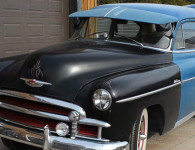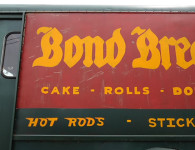A summer charity motor rally in The Department’s 1941 Ford found us sitting in a large airport hangar, enjoying lunch. We had spent the morning clad in flat caps and goggles, driving the farm roads and well-to-do neighbourhoods of southern Ontario in the name of a good cause. Now, with a fine meal before us, chatter among the participants was in full swing when another joined us at our table. He was wearing a cap and vintage flight suit. Coincidentally, we had both parked our modes of transportation just outside. Ours, the 1941 Ford pickup. His, a 1941 Tiger Moth.
Bob Murphy is an architect by trade who had always wanted a Tiger Moth to fly. School, then marriage, and then family had delayed his purchase for years, but finally he decided it was time. He found, then imported (from the other side of the world) a basket of parts that had once been a Tiger Moth. Then began a the long process of restoring it. Finally, after ten years of scrounging, rebuilding, fabricating and learning new skills, he got his Moth aloft.
The Tiger Moth is a fascinating aircraft. Here, Bob describes in greater detail exactly what it was used for, and why it was so good for that.
Factsheet on the 1941 Tiger Moth
- trainer aircraft
- designed and built by the de Havilland Aircraft Company
- production: 8000-9000 units (1931-1944)
- used by British, Canadian, Australia, New Zealand, Polish, Egyptian, Sri Lankan (Ceylon), Burmese, Greek, Norwegian, Swedish Air Forces
- wingspan: 8.94 metres (29 feet)
- length: 7.29 metres (23 feet)
- motor: 4 cylinder- 130hp
- speed: 160 kilometres per hour
- post-war surplus price: $25
- current price of a restored Tiger Moth: $100,000






















No comments